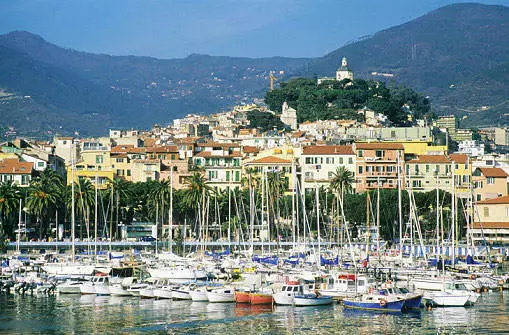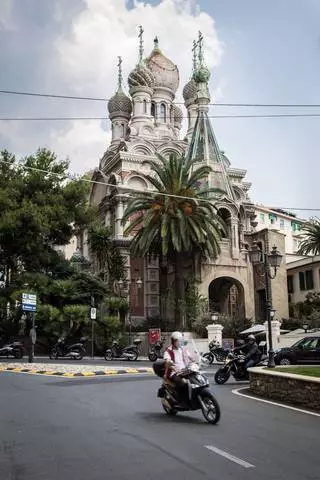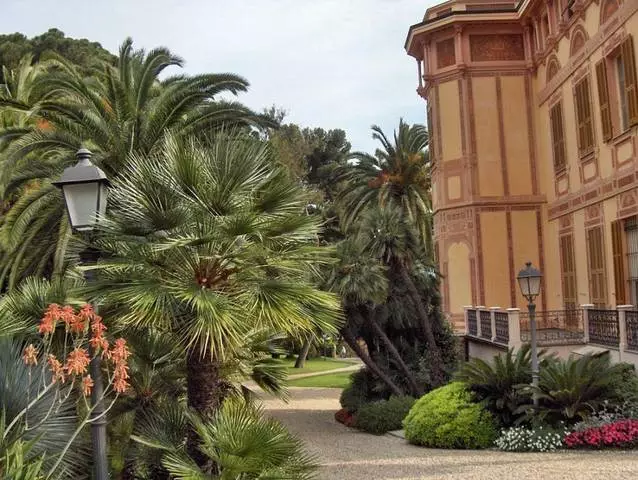San Remo is the most luxurious resort on the west coast of Liguria. It is the territory of palm trees, beautiful parks and gardens with exotic plants, many boutiques, with a chic casino, cheerful and festive atmosphere. However, there are also typical minuses inherent in the city - such as noise from cars and others.

San Remo, begged on the "flower riviera", which was named so thanks to the developed flower industry, also earned the nickname of the "city of flowers". Floral greenhouses spread everywhere around San Remo, thanks to which the fragrance of roses, carnations, buttercasters and other colors of both the European Region and others are dominated here.
The resort developed in the nineteenth century, while the cream of European society was gathered in this city, in particular, many visitors were from Russia. Mary Fedorovna - Mother Nicholas Second - in San Remo was once a crowd of fans. In addition, his wife rested here - Empress Alexander Fodorovna. As the memory of high guests from Russia in San Remo is the magnificent structure of the Orthodox Church, which has such familiar and favorite juices of the dome-lows. In San Remo, it never happens in San Remo - constantly heard the buzz of scooters, twitter of local residents and spending the spell of Italian men, as well as the exclamations of delight visitors. In particular, when numerous festivals go to San Remo.
The old heart of the city is La Piania, or the "pine cone" is a quarter lying north of Corso Matteori, which in turn is the main artery of San Remo.
Beaches in San Remo
Beaches at this resort sand-pebble, they have a good infrastructure, however, not the best quality. There are a large number of prestigious hotels, many of these institutions are placed in beautiful palace buildings, and next door to them there are hotels that appropriate the level of service for two or three "stars", as well as a large number of residences, which are located on the second third lines of the beach. Hotels and beaches are divided by expensive.
Sights of the resort
Church of Christ the Savior
The city is decorated with the building of the Cathedral of Christ the Savior, referred to as simplified by the Russian Church. It was erected according to the architectural plan A.V. Schuseva, whose merit is also the Mausoleum of Lenin, located in Moscow. Supervised the construction of architects of drinking age. The temple was built in 1913 according to the style of the seventeenth century churches. The construction has decorations in the form of a stone thread and tiles, and nearby can be seen a bell tower with a tent roof. In the building, you can look at the exhibition of Russian orthodox icons.
The decision of the Empress of Mary Alexandrovna, the wife of Alexander the second, spend the winter at this resort, was a significant event for San Remo. For the government, Russian nobles began to ride here, and San Remo became the center of winter pastime. Here at the time more than a thousand Russians lived. The Empress initiated the construction of the Orthodox Church, Nikolai the second was one of the main benefactors.
The brick construction was crowned with five domes with crosses in Russian traditions, the height of the highest of them is fifty meters. Despite the bright exterior of the church, its inner decoration is very modest. The main decoration is the wonderful iconostasis. There are two copies of the paintings of Mikhail Vrubel - these are the icons of Christ and God's Mother. The originals are located in other churches - the Church of St. Cyril and in the Vladimir Cathedral of Kiev. The features of this building are two monument, which is located in the courtyard - these are busts of the spouses of Viktor Emmanuel Third and Elena Savoy, who ruled the country during the construction of the temple. Parents Elena and she herself, during preceding marriage, were Orthodox. When her parents died, they were buried here in the courtyard, but later they were reburied in their homeland - in the city of Cetina. Montenegro in gratitude for it sacrificed the temple of two bells, which are located under the dome. During the Second World War, a bomb hit the temple. She struck the roof of the construction and stuck in the floor, but did not explode. Nowadays, the Church of Christ the Savior is the current church, religious ministries are constantly organized here.

For the entrance, one euro will need to pay, work schedule: from 9:30 to 12:00 and from 15:00 to 18:00.
Villa Alfred Nobel
This building of the Moorish style was built in 1874. Its facade has a decoration in the traditions of the Venetian Renaissance. The villa is surrounded by a garden, in it, such valuable representatives of the flora are growing as large-scale cypresses. However, the glory of this villa is based on the fact that Alfred Nobel lived here for the last five years before his death. This Swedish chemist is the founder of the famous Prize - Nobel.
Restoration work was carried out at the villa, however, the spirit of the nineteenth century was saved here - the interior of all rooms corresponds to that period. The basement houses a museum in which you can learn about the innovative activities of the scientist. The conference room decorated with Wine Frescoes is located on the first floor of the villa. The construction is often rented - the garden spaces are used for various solemn events.

Nowadays, Villa Nobel is open to any visitor, the entrance is free here - only a preliminary entry for a organized excursion is necessary.
Villa Hanbury.
Sightstitality of another villa - Villa Hanbury - is the Botanical Garden located there. The villa is close to San Remo, here you can see more than 5800 species of exotic representatives of the plant world.
City Museum
In addition, everything, in San Remo there is a city museum. Here are only a few rooms, some have decoration in the form of ceiling frescoes. You have here you have the opportunity to get acquainted with prehistoric and Roman archaeological finds that have discovered in this area. Exposures are also regularly organized here. As for artistic art, the work of Maurizio Carrey is notable - "Gloria Di-San Napoleon", dated 1808th year as coarse podhalimage in relation to Corsican despota Bonaparte, as well as bronze figures of the authorship of Franco Bargiggia.
